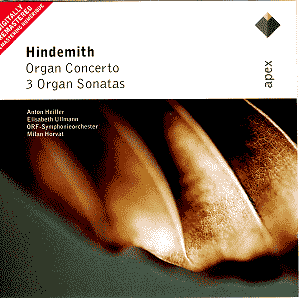Comparison recordings of the sonatas:
E. Power Biggs, Busch-Reisinger organ,
Cambridge, MA, USA CBS LP CMS 6234
Piet Kee, Müller organ of St. Bavo,
Haarlem, Netherlands Chandos 9097
I have numbered this
concerto #2 above to distinguish it
from the "Kammermusik #7"
Op 46 #2 (1928) which is by all rights
Hindemith’s organ concerto #1. This
second concerto was commissioned by
the New York Philharmonic Orchestra
and was premiered in 1962; it is Hindemith’s
last symphonic work. Like much late
Hindemith it is thoughtful and well
constructed with less of the impishness
of the earlier works.
Hindemith at this late
hour of his life was depressed and disillusioned.
Five years previously his greatest opera
on which he had laboured for decades
had been furiously attacked by scholars,
critics, and press alike (After its
premier in 1957 it was buried, not to
see the light of day again until this
year). He demanded deference and honours
and was dissatisfied with whatever he
received, and so even his bitterness
was also held against him. He succeeded
in living only three years longer than
Bach. So, those who know the jocular
earlier organ concerto may be disappointed
to find this one at times anguished
and tense with echoes of Karl Amadeus
Hartmann. The fun has turned sarcastic
and satirical, but the cleanness of
the harmonies remains as does the assurance
of a beautiful future to come. If you
love late Hindemith you will love this
work, but if all you know is the earlier
ebullience, there may be a little bit
here to get used to. The performance
is superb, all that one could hope for,
and the sound is also excellent, the
balance between organ and orchestra
absolutely exemplary. Like many phase
accurate organ recordings, it will open
up nicely in your Dolby Surround decoder,
although it is, of course, a two channel
recording.
This is certainly the
finest version of the organ sonatas
I’ve heard. The Flentrop organ is clear
with the voices independently audible,
yet when necessary the sound has mass
and depth. The Biggs recording is also
very good, but the sound of these old
CBS LP recordings, such wonders of high
fidelity in their day, show their age
now. The Chandos recording is an unusual
one, recorded in a more reverberant
acoustic than one is used to for these
works. This has the effect of emphasising
the vertical or harmonic dimension while
blurring the horizontal structure. The
music survives this treatment, of course;
if you have been put off by the Hindemith
sonatas because they seem to you to
be too shrill or too flippant, too much
like calliope music, you might find
this approach to your liking.
Paul Shoemaker
